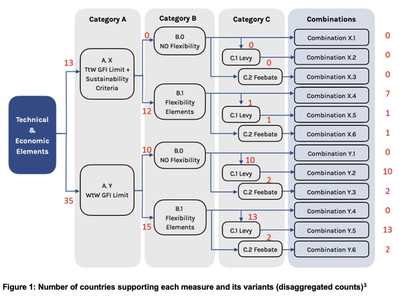Momentum Builds For a Universal GHG Price
The 16th Meeting of the Intersessional Working Group on Reduction of GHG Emissions from Ships concluded with some progress made on the finalization of mid-term measures, and without a decisive shift in the landscape of positions and preferences.
This meeting was the first convening of the IMO following the adoption of the Revised GHG Strategy in July 2023.
Although it was already agreed in the Revised GHG Strategy to adopt both a GHG Fuel Standard (a mandate on GHG intensity of fuel/energy), as well as a GHG pricing regulation, the IMO secretariat and member states must now reach agreement on specific and detailed regulation. This is a process that IMO has committed to finalise within approximately 12 months. Agreement on MARPOL amendment language is scheduled for MEPC 83 which is in Spring 2025.
Dr Tristan Smith, Director of consultancy UMAS and Associate Professor at UCL, said: “It is hard to overstate the significance of what might be agreed in Spring 2025. The specifics of these policy measures will determine the shape of international shipping, capital flows in the maritime value chains and have major implications for the economies of many countries and global trade. Given this significance, ISWG-GHG 16 provides some important clues on where preferences are developing. However, this is still an early stage in the debate, with key evidence of the impacts and costs of different policy specifics expected this summer, and with so many interconnected moving parts, a scenario view e.g. considering a range of scenarios of potential outcome is still needed.”
One key detail has clarified at ISWG-GHG 16 – that the GHG intensity limits of the GHG Fuel Standard (now referred to as a goal-based marine fuel standard) will be set according to both the GHG reduction targets and the indicative checkpoints. The term ‘indicative checkpoints’ was dismissed by many at the point of adoption of the Revised Strategy in 2023.
For the way this fuel standard might be complemented by a GHG pricing mechanism, there is an approximately even balance of member states supporting three different architectures:
• 14 countries, primarily but not limited to middle income economies, expressed a preference for a fuel standard which includes flexibility (referred to as credit trading mechanism or emission trading system (ETS)), and with no further GHG pricing mechanism e.g. levy
• 18 countries, primarily but not limited to small island developing states and least developed countries, expressed a preference for a simplified fuel standard which excludes flexibility, working in combination with a universal GHG price e.g. a levy
• 16 countries, primarily but not limited to developed economies, expressed a preference for a fuel standard which includes flexibility (credit trading mechanism or ETS), and a universal GHG pricing mechanism e,g, a levy.
There were differences between member states on how the revenues should be disbursed. These differences are broadly consistent with differences that have been expressed in previous rounds of discussions on mid-term measures and GHG pricing. The differences are not surprising or abnormal given the meeting is not a decision point and therefore is not a point at which many member states will not be ready to compromise, says Smith.
Relative to the debate at ISWG-GHG 15 in June 2023, the number of countries supporting a universal GHG price has shown a small increase in absolute terms, and a larger increase in percentage terms (percent of those member states supporting). Perhaps most significantly, it showed a significant growth in support from SIDS relative to the ISWG-GHG 15 debate.
Overall the meeting therefore has continued to progress the finalisation phase, albeit without a decisive shift in the landscape of positions and preferences, whilst also retaining progress in line with agreeing specifics at MEPC 83 in June – a commitment reiterated by member states with a range of different preferences on specifics.














